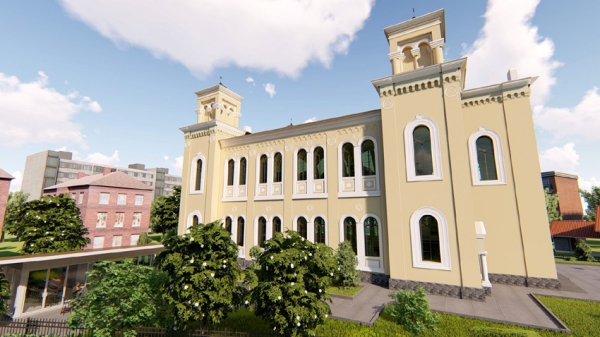The abandoned Vidin Synagogue is situated in Kaleto residential district in the Danube city of Vidin. Although time and peoples’ negligence took some of its beauty, the former house of prayer still keeps the dignity built in by Italian architects over a century ago.
The Vidin Synagogue keeps the memory of the tolerant co-existence between Bulgarians, Turks, Armenians and Roma until the middle of the 20th century; of the yellow stars the Jewish people had to wear in public between 1941 and 1944 when Bulgaria was an ally with the Third Reich; of the voluntary deportation of 1,200 Jews from the city of Vidin to the new state of Israel in the 1950s. The synagogue lost its function as a house of prayer in the middle of the 1950s.
However, the Vidin Synagogue may regain its old look, if the project for its restoration is completed successfully, unlike the unfortunate attempt in the 1980s which brought the wonderful building to ruin.
In the 1980’s the authorities decided to replace the roof of the synagogue. Later, the roof of the building was removed and a huge crane was brought, architect Lubomir Stanislavov who is an author of the project for the restoration of the Vidin Synagogue reminds.
However, in 1986 the construction company removed the crane and left the construction site due to shortage of money. The new metallic construction was completely abandoned and the authorities did nothing to protect the building from the influence of the atmospheric conditions, which is equal to vandalism. The synagogue now looks like a ruin, because of their decision to place the crane inside.
In 2017 the Organization of the Jews in Bulgaria Shalom donated the synagogue to the Vidin Municipality which promised to restore the building and turn it into a cultural center named after the renowned Bulgarian-born French expressionist painter Jules Paskin. The local authority managed to find financing under the Regions in Growth Operational Programme. It borrowed a loan from the Urban Development Fund to the tune of EUR 5 million. Thus, the synagogue is expected to be fully renovated by the end of 2019.
The Vidin Synagogue will resume its original look. Fortunately we have some well-preserved archive documents and photographs which will help us make the house of prayer look impressive again, as it was 125 years ago when it was constructed. The most-valuable historical buildings in Vidin are situated within a radius of 100 meters, which is not accidental.
In architect Stanislavov’s words, this house of prayer is a triple-nave basilica with a narthex. It consists of galleries and four towers. The Vidin Synagogue is a huge building and an inseparable part of the history of this Danube city. It is also the second-largest synagogue along the Danube after the Budapest Synagogue and the second-largest Jewish house of prayer in Bulgaria after the Sofia Synagogue.
The building will be turned into a large multi-purpose hall with wonderful acoustics and will host different events-concerts, exhibitions, meetings and even parties, Lumobir Stanislavov went on to say. Special areas on the second floor will host exhibitions connected to the Holocaust and Jules Paskin’s work of art. The library and the premises of the Organization of the Jews in Bulgaria Shalom will be also on the second level of the synagogue building. Of course, the synagogue will be open for tourists as well and visitors will have the opportunity to buy souvenirs, brochures and books about the history of the Vidin Synagogue. The city of Vidin will have a true fortune once the synagogue is fully renovated. A modern large sports hall has already been built in the city. Soon, the Vidin Synagogue will be able to host large cultural events.
Once, Vidin was a center of one of the largest Jewish communities in Bulgaria. Now a few representatives of the Jewish community live in this Bulgarian city. However, their house of prayer will keep forever the memory of the Bulgarians who stood united, in order to rescue the Bulgarian Jews from deportation to the Auschwitz death camps.
Media Link : Vidin Synagogue revives as cultural center named after Jules Paskin





